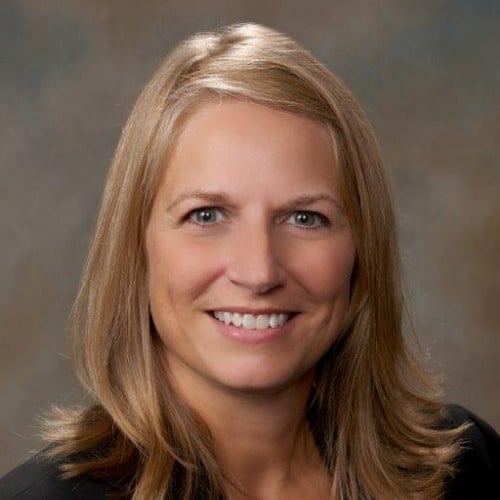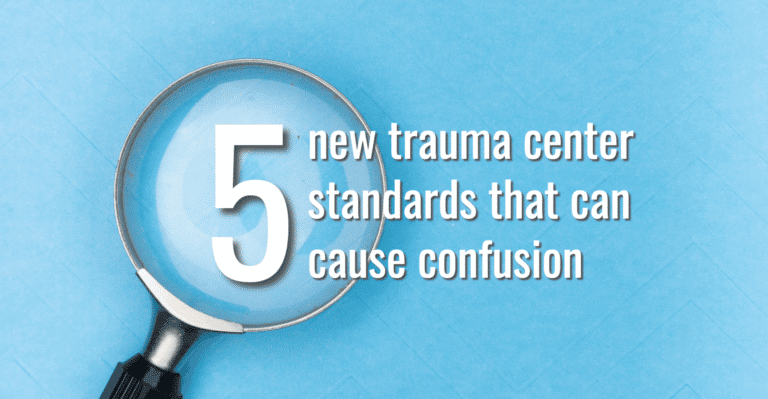The new edition of Resources for Optimal Care of the Injured Patient from the American College of Surgeons (ACS) has clarified several issues in trauma center verification. However, it also includes some new standards that many trauma program leaders find difficult to interpret.
During my recent webinar — Town Hall Meeting to Discuss the New Trauma Center Standards — attendees raised several great questions about the new ACS requirements. The discussion covered a range of issues, from staffing and education standards to requirements covering specialty response, data quality planning and trauma PI.
In this article, I walk through my answers to five challenging questions asked by the trauma community.
But before I get started, let me clarify that the recommendations below are based on my personal experience working with trauma programs nationwide. Trauma program leaders should look to the ACS for official interpretation of the 2022 Standards.
1. Do isolated hip fractures need to be reviewed?
The 2022 Standards have strengthened the requirement that trauma program staff review nonsurgical admissions (NSAs).
- Previously, only programs that admitted more than 10% of injured patients to nonsurgical services were required to review all NSAs through the PIPS process (Orange Book CD 5-18).
- Under the new standards, “In all trauma centers, all nonsurgical trauma admissions must be reviewed by the trauma program” (Standard 7.8, emphasis added).

However, attendees at the recent webinar noted an apparent conflict. A different standard — Standard 7.2 — provides a list of audit filters that must be included in every center’s written PIPS plan. One of these required audit filters is “All nonsurgical admissions (excludes isolated hip fractures)”.
To many trauma leaders, this implies that an NSA for isolated hip fracture (IHF) does not need to be reviewed. So how should we look at these requirements?
Hopefully, the ACS will provide clarification on this issue. Until then, the best course is to focus on some basic PI concepts:
- First, a PI program does not need to review issues that are not captured in the trauma registry. Some states do not require IHF in trauma inclusion criteria; as a result, many trauma centers do not track IHF. So if your center does not track IHF in the registry, then you do not need to review NSAs for IHF.
- Second, even if your program does track IHF in the trauma registry, the issue is whether or not there was a variance in care. For example, say your program has a clinical practice guideline (CPG) that states, “IHF patients with ground level fall and no need for ICU care can be admitted to a nonsurgical service.” If an IHF patient meets these conditions and is discharged alive, then he or she does not need to be reviewed for NSA.
In other words, if your program tracks IHF in the trauma registry, all IHF NSAs should be reviewed unless they were clearly appropriate under an existing CPG.
NOTE: This point was clarified in the December 2022 revision of the ACS standards. In Standard 7.2, the audit filter in question is now “All nonsurgical admissions (refer to Standard 7.8)”. For more information, read ACS releases December 2022 revision of trauma standards — what exactly changed?
2. Which specialists need to respond to the bedside?
One helpful thing about the 2022 Standards is that they are more clear about which patients require a specialist response. However, webinar attendees noted a pair of requirements that can lead to confusion:
- Standard 5.21 reads: “In all trauma centers, an orthopedic surgeon must be at bedside within 30 minutes of request for the following…” (emphasis added)
- But elsewhere, Standard 5.17 reads: “Neurosurgical evaluation must occur within 30 minutes of request for the following…”
There is no conflict here. However, the wording of these parallel standards does raise the question: Is a bedside response no longer required for neurosurgery?
Avery Nathens, MD, MPH, PhD, medical director of ACS trauma quality programs, shed light on this issue during one of his talks at the 2021 Trauma Quality Improvement Program (TQIP) Annual Conference.
Commenting on Standard 5.17, Dr. Nathens said: “Neurosurgeon response times are still within 30 minutes of request … We specify neurosurgical ‘evaluation’ rather than being at the bedside because much of the evaluation means looking at a CT scan and getting information about what the patient looks like — [for example,] blown pupils or lateralizing signs.”
This does not mean that neurosurgeons can phone in every evaluation. It just means that an appropriate neurosurgical response does not always have to include immediate arrival at bedside.
3. Can family medicine physicians fulfill the IM coverage requirement?
Questions also arose regarding the availability of medical specialists. According to Standard 4.25, Level III centers must have internal medicine (IM) available continuously. The problem is that many Level III centers do not have access to IM physicians. One webinar participant noted that the vast majority of physicians at his Level III center are family medicine providers.
So the question is, Do the new standards allow Level III centers to use family medicine hospitalists for IM call coverage?
Hopefully, the ACS will clarify this issue in the near future. Until then, my recommendation is that hospitals using family medicine specialists for IM call coverage should continue with this model.
I have worked with several trauma centers that do not have IM physicians fulfilling hospitalist roles. In my experience, surveyors have always accepted this approach. In fact, I would be very surprised if the ACS took a hard stance on this requirement considering that family medicine specialists are widely accepted as qualified to provide hospitalist coverage.
One note: Be sure to track issues or events related to hospitalist coverage through your PI process, and follow patients attended by a family medicine hospitalist for unexpected occurrences. Using the PI process to demonstrate the safety of this coverage model can deflect any surveyor concerns.
4. Does the “dedicated ortho OR” have to be a room used for nothing but fracture fixation?
Several webinar attendees expressed concerns about Standard 3.3: “Level I and II trauma centers must have a dedicated OR prioritized for fracture care in nonemergent orthopaedic trauma.”
Does this mean that these centers need to keep an empty operating room staffed and ready for fracture fixations?
Again, official clarification from the ACS would be welcome. However, in my opinion the key to understanding this requirement is to look at it in the context of Standard 3.1, the OR availability standard for all trauma patients:
- Standard 3.1 specifies that in Level I and II centers, an OR must be staffed and available for trauma patients within 15 minutes of notification (30 minutes for Level III centers).
- It is generally understood that this does not mean a designated OR must stand staffed and empty at all times waiting for trauma patients.
The fact is that the majority of trauma centers do not have designated trauma rooms that are held empty on standby. In most centers, trauma patients just go to the next available OR, and the department has processes in place for expediting access.In my experience, ACS surveyors do not expect centers to have empty ORs staffed and ready for trauma patients. They just expect centers to be able to open an OR for an injured patient without delay.
Returning to the new ortho trauma room requirement, here are a few keys to making sure orthopaedic surgeons have predictable access to the OR:
- Work with the orthopaedic surgery department to create a system that everyone can live with. (This aligns with the “additional information” under Standard 3.3, which states, “Operational details related to staffing, frequency of availability, and use by other services should be collaboratively determined and approved by the TMD and the orthopaedic trauma leader.”)
- Incorporate orthopaedic trauma time into the OR block schedule. Orthopaedic surgery should have a nonemergent fracture block with zero release. (Note: If your OR struggles to accommodate nonemergent ortho, check its current block utilization rates. If average block utilization is below 50%, the root problem is inefficiency in the OR schedule.)
- As always, monitor performance for the nonemergent fracture patient group. Standard 3.3 additional information states, “The frequency of availability should be sufficient to provide timely fracture care for patients.”
5. Can a TMD hold membership in one organization and attend the meeting of another?
According to Standard 2.8, “In Level I trauma centers, the TMD must hold active membership in at least one national trauma organization and have attended at least one meeting during the verification cycle”. For Level II and III centers, membership in a regional or state organization is acceptable.
An interesting question came up during the webinar: If a TMD is a member of EAST, for example, but attends a different national trauma meeting, does that fulfill the requirement?
Here’s my take: While the standard may not be perfectly precise on this point, the intention is clear. The words “active membership” strongly imply that the TMD must attend the national meeting of the organization he or she is a member of. Another way of looking at it is that active participation in an organization implies taking part in the organization’s gatherings.
So in my opinion, program leaders should assume that if the TMD is a member of EAST, attending the annual meeting of AAST (or vice versa) does not fulfill Standard 2.8.
Bonus question: Does TQIP count as a “national trauma organization”?
This interesting question was raised during the webinar. If the answer is yes, then there a lot of TMDs out there who can “check the box” for Standard 2.8 just by attending the TQIP annual meeting
But this is how I look at: Most ACS-verified trauma centers already take part in TQIP, and the new Standard 7.4 (“Participation in Risk-Adjusted Benchmarking Programs”) will probably push participation rates even higher. If participating in TQIP fulfilled the “national trauma organization” requirement, it would make Standard 2.8 pointless.
So in my view, a TMD cannot fulfill Standard 2.8 through his or her center’s participation in TQIP. For more clarity, it may be helpful to look at Chapter 5 of the Orange Book. While no longer in force, this chapter provides a useful reference on what the ACS considers to be appropriate organizations for TMD participation.
Submit questions to the ACS
Once more, let me emphasize that these perspectives are not an authoritative interpretation of the new trauma center standards. The recommendations above are based on my personal experience helping trauma centers work through verification issues and prepare for site surveys.
If you’re like most trauma program leaders, you still have questions. The American College of Surgeons has created a tool for gathering questions about the new trauma center standards. To submit your questions to the ACS, visit the college’s Resources for Optimal Care of the Injured Patient 2022 Standards Feedback Survey.
Angie Chisolm, MBA, BSN, RN, CFRN, TCRN is managing partner at Peregrine Health Services. She is a nationally recognized expert in trauma program operational efficiency, coding and billing, site survey readiness and performance improvement. Angie is also chief operating officer and co-founder of National Quality Systems (NQS), a data management platform for trauma centers.

